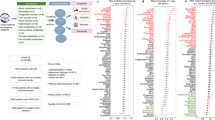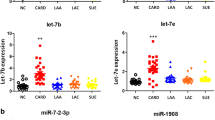Abstract
An accurate etiological classification is key to optimize secondary prevention after ischemic stroke, but the cause remains undetermined in one third of patients. Several studies pointed out the usefulness of circulating gene expression markers to discriminate cardioembolic (CE) strokes, mainly due to atrial fibrillation (AF), while only exploring them in small cohorts. A systematic review of studies analyzing high-throughput gene expression in blood samples to discriminate CE strokes was performed. Significantly dysregulated genes were considered as candidates, and a selection of them was validated by RT-qPCR in 100 patients with defined CE or atherothrombotic (LAA) stroke etiology. Longitudinal performance was evaluated in 12 patients at three time points. Their usefulness as biomarkers for AF was tested in 120 cryptogenic strokes and 100 individuals at high-risk for stroke. Three published studies plus three unpublished datasets were considered for candidate selection. Sixty-seven genes were found dysregulated in CE strokes. CREM, PELI1, and ZAK were verified to be up-regulated in CE vs LAA (p = 0.010, p = 0.003, p < 0.001, respectively), without changes in their expression within the first 24 h after stroke onset. The combined up-regulation of these three biomarkers increased the probability of suffering from CE stroke by 23-fold. In cryptogenic strokes with subsequent AF detection, PELI1 and CREM showed overexpression (p = 0.017, p = 0.059, respectively), whereas in high-risk asymptomatic populations, all three genes showed potential to detect AF (p = 0.007, p = 0.007, p = 0.015). The proved discriminatory capacity of these gene expression markers to detect cardioembolism even in cryptogenic strokes and asymptomatic high-risk populations might bring up their use as biomarkers.



Similar content being viewed by others
References
The burden of Stroke in Europe report. King’s College London for the Stroke Alliance for Europe (SAFE). Brussels, May 11th 2017.
Hankey GJ. Secondary stroke prevention. Lancet Neurol Elsevier Ltd. 2013;4422:1–17.
Adams HP, Bendixen BH, Kappelle LJ, Biller J, Love BB, Gordon DL, et al. Classification of subtype of acute ischemic stroke. Definitions for use in a multicenter clinical trial. TOAST. Trial of Org 10172 in Acute Stroke Treatment. Stroke. American Heart Association, Inc.; 1993;24:35–41.
Freeman WD, Aguilar MI. Prevention of Cardioembolic stroke. Neurotherapeutics. 2011;8:488–502.
Hart RG, Pearce LA, Aguilar MI. Meta-analysis: antithrombotic therapy to prevent stroke in patients who have Nonvalvular atrial fibrillation. Ann Intern Med. 2007;146:857–67.
Kamel H, Healey JS. Cardioembolic stroke. Circ Res. 2017;120:514–26.
Kernan WN, Ovbiagele B, Black HR, Bravata DM, Chimowitz MI, Ezekowitz MD, et al. AHA / ASA guideline guidelines for the prevention of stroke in patients with stroke and transient ischemic attack. Stroke. 2014;45:2160–236.
Amarenco P, Bogousslavsky J, Caplan LR, Donnan GAHM. Classification of stroke subtypes. Cerebrovasc Dis. 2009;27:493–501.
Hart RG, Catanese L, Perera KS, Ntaios G, Connolly SJ. Embolic stroke of undetermined source: a systematic review and clinical update. Stroke. 2017;48:867–72.
Hart RG, Sharma M, Mundl H, Kasner SE, Bangdiwala SI, Berkowitz SD, et al. Rivaroxaban for stroke prevention after embolic stroke of undetermined source. N Engl J Med. 2018;378:2191–201.
Sonderer J, Kahles MK. Aetiological blood biomarkers of ischaemic stroke. Swiss Med Wkly. 2015:1–15.
Llombart V, Antolin-Fontes A, Bustamante A, Giralt D, Rost NS, Furie K, et al. B-type natriuretic peptides help in Cardioembolic stroke diagnosis. Stroke. 2015;46:1187–95.
Katan M, Moon YP, Paik MC, Wolfert RL, Sacco RL, Elkind MSV. Lipoprotein-associated phospholipase A2 is associated with atherosclerotic stroke risk: the northern Manhattan study. PLoS One. 2014;9:e83393.
Sharp FR, Jickling GC, Stamova B, Tian Y, Zhan X, Liu D, et al. Molecular markers and mechanisms of stroke: RNA studies of blood in animals and humans. J Cereb Blood Flow Metab Nature Publishing Group. 2011;31:1513–31.
Moher D, Liberati A, Tetzlaff J, Altman DG, The PRISMA Group. Preferred Reporting Items for Systematic Reviews and Meta-Analyses: The PRISMA Statement. PLoS Med. Public Libr Sci. 2009;6:e1000097.
Harms H, Prass K, Meisel C, Klehmet J, Rogge W, Drenckhahn C, et al. Preventive antibacterial therapy in acute ischemic stroke: a randomized controlled trial. PLoS One. 2008;3:e2158.
Brott T, Adams HP, Olinger CP, Marler JR, Barsan WG, Biller J, et al. Measurements of acute cerebral infarction: a clinical examination scale. Stroke. 1989;20:864–70.
van Swieten JC, Koudstaal PJ, Visser MC, Schouten HJ, van Gijn J. Interobserver agreement for the assessment of handicap in stroke patients. Stroke. 1988;19:604–7.
Pagola J, Juega J, Francisco-Pascual J, Moya A, Sanchis M, Bustamante A, et al. Yield of atrial fibrillation detection with textile wearable Holter from the acute phase of stroke: pilot study of crypto-AF registry. Int J Cardiol Elsevier Ireland Ltd. 2018;251:45–50.
Lip GYH, Nieuwlaat R, Pisters R, Lane DA, Crijns HJGM. Refining clinical risk stratification for predicting stroke and thromboembolism in atrial fibrillation using a novel risk factor-based approach. Chest. 2010;137:263–72.
Xu H, Tang Y, Liu D, Ran R, Ander BP, Apperson M, et al. Gene expression in peripheral blood differs after cardioembolic compared with large-vessel atherosclerotic stroke: biomarkers for the etiology of ischemic stroke. J Cereb Blood Flow Metab. 2008;28:1320–8.
Jickling GC, Xu H, Stamova B, Ander BP, Zhan X, Tian Y, et al. Signatures of Cardioembolic and large-vessel ischemic stroke. Ann Neurol. 2010;68:681–92.
Stamova B, Jickling GC, Ander BP, Zhan X, Liu D, Turner R, et al. Gene expression in peripheral immune cells following Cardioembolic stroke is sexually dimorphic. PLoS One. 2014;9:1–9.
Guichard J, Nattel S. Atrial cardiomyopathy. J Am Coll Cardiol Elsevier. 2017;70:756–65.
Elkind MSV. Atrial Cardiopathy and stroke prevention. Curr Cardiol Rep. 2018;20:103.
Orekhov AN, Mukhamedova N, Ivanova EA, Rizzo M. PPAR in cardiovascular disorders. PPAR Res Hindawi Publishing Corporation; 2016;2016.
Zhang Y, Xu H, Yu F, Wang M, Li M, Xu T, et al. Crosstalk between microRNAs and peroxisome proliferator-activated receptors and their emerging regulatory roles in cardiovascular pathophysiology. PPAR Res. 2018;2018:1–11.
Ou F, Rao N, Jiang X, Qian M, Feng W, Yin L, et al. Analysis on differential gene expression data for prediction of new biological features in permanent atrial fibrillation. PLoS One. 2013;8:e76166.
Sawada N, Li YLJ. Novel aspects of the roles of Rac1 GTPase in the cardiovascular system. Curr Opin Pharmacol. 2010;10:116–21.
Guo Y, Lip GYH, Apostolakis S. Inflammation in atrial fibrillation. J Am Coll Cardiol. Elsevier Inc.; 2012;60:2263–70.
Tuttolomondo A, Di Raimondo D, Pecoraro R, Arnao V, Pinto A, Licata G. Inflammation in ischemic stroke subtypes. Curr Pharm Des. 2012;18:4289–310.
Benedetta P, Dolors G, Alejandro B, Victor L, Teresa G, Domenico I, et al. Blood markers of inflammation and endothelial dysfunction in cardioembolic stroke: systematic review and meta-analysis. Biomarkers Taylor & Francis; 2017;22:200–9.
Licata G, Tuttolomondo A, Di Raimondo D, Corrao S, Di Sciacca R. Immuno-inflammatory activation in acute cardio-embolic strokes in comparison with other subtypes of ischaemic stroke. Thromb Haemost. 2009;101:929–37.
Hu YF, Chen YJ, Lin YJ, Chen SA. Inflammation and the pathogenesis of atrial fibrillation. Nat Rev Cardiol Nature Publishing Group. 2015;12:230–43.
Rauen T, Hedrich CM. Klaus Tenbrock GCT. cAMP responsive element modulator: a critical regulator of cytokine production. Trends Mol Med. 2014;19:262–9.
Muller FU, Lewin G, Baba HA, Boknı P, Fabritz L, Kirchhefer U, et al. Heart-directed expression of a human cardiac isoform of cAMP-response element modulator in transgenic mice. J Biol Chem. 2005;280:6906–14.
Elmar HB, Bernhard K, Uwe B. Wide distribution of CREM immunoreactivity in adult and fetal human brain, with an increased expression in dentate gyrus neurons of Alzheimer’s as compared to normal aging brains. Amino Acids. 2013;45:1373–83.
Bukowska A, Felgendreher M, Scholz B, Wolke C, Schulte JS, Fehrmann E, et al. CREM-transgene mice: an animal model of atrial fi brillation and thrombogenesis. Thromb Res. 2019;163:172–9.
Schauvliege R, Janssens S, Beyaert R. Pellino proteins: novel players in TLR and IL-1R signalling. J Cell Mol Med. 2007;11:453–61.
Gesuete R, Kohama SG, Poore MS. Toll-like receptors and ischemic brain injury. J Neuropathol Exp Neurol. 2015;73:378–86.
Gurses KM, Kocyigit D, Yalcin MU, Canpinar H, Yorgun H, Sahiner ML, et al. Monocyte toll-like receptor expression in patients with atrial fibrillation. Am J Cardiol Elsevier Ltd. 2016;117:1463–7.
Scott L, Li N, Dobrev D. Role of inflammatory signaling in atrial fibrillation. Int J Cardiol. 2019;287:195–200.
Song J, Zhu Y, Li J, Liu J, Gao Y, Ha T, et al. Pellino1-mediated TGF- β 1 synthesis contributes to mechanical stress induced cardiac fi broblast activation. J Mol Cell Cardiol. Elsevier Ltd. 2015;79:145–56.
Dzeshka MS, Lip GY, Snezhitskiy VS. Cardiac fibrosis in patients with atrial fibrillation. Mechanisms and clinical implications. J Am Coll Cardiol. 2015;66:943–59.
Liu T, Huang C, Chu Y, Wei C, Chou C, Chou M, et al. Cloning and expression of ZAK, a mixed lineage kinase-like protein containing a leucine-zipper and a sterile-alpha motif. Biochem Biophys Res Commun 2000;816:811–816.
Strle K, Broussard SR, McCusker RH, Shen W-H, LeCleir JM, Johnson RW, et al. C-jun N-terminal kinase mediates tumor necrosis factor-alpha suppression of differentiation in myoblasts. Endocrinology United States. 2006;147:4363–73.
Lu Y, Chen Y, Kao Y, Chen S, Chen Y. Extracellular matrix of collagen modulates arrhythmogenic activity of pulmonary veins through p38 MAPK activation. J Mol Cell Cardiol Elsevier Ltd. 2013;59:159–66.
Yaghi S, Kamel H, Elkind MSV. Atrial cardiopathy: a mechanism of cryptogenic stroke. Expert Rev Cardiovasc Ther. 2017;15:591–9.
Swyngedouw NE, Jickling GC. RNA as a stroke biomarker. Future Neurol. 2017;12:71–8.
Funding
Neurovascular Research Laboratory acknowledges funding for this project by PI15/00354 and PI18/804 grant from Fondo de Investigaciones Sanitarias and takes part in the Spanish stroke research network INVICTUS+ (RD16/0019/0021) of the Instituto de Salud Carlos III (co-financed by the European Regional Development Fund, FEDER). Moreover, it has been partially financed by 201528-30-31-3 grant from Fundació la Marató de TV3.
A.B is supported by a Juan Rodés research contract JR16/00008 from the Instituto de Salud Carlos III.
Some parts of this work were done in collaborative agreement through the International Biomarker in Cerebrovascular Diseases (IBCD) study group.
Author information
Authors and Affiliations
Contributions
T.G-B helped in the experimental design. B.P and T.G-B performed the articles searching and screening and, together with M.C, extracted data from selected articles. A.P, A.N, N.G, M.C, and H.H performed the experimental work. T.G-B, I.F-C, A.M, C.M, and GC.J generated original microarrays data. A.B, MA.M, JL.C-E, A.P, J.P, J.J, and J.M recruited patients and selected samples included in the verification assays. T.G-B and E.P performed statistical and bioinformatics analyses and contributed to the interpretation of results. J.M planned the whole project. T.G-B and E.P drafted the manuscript. All authors have critically reviewed the manuscript and approved the final article version.
Corresponding author
Ethics declarations
Conflict of Interest
The authors declare that they have no conflict of interest.
Ethical Approval
All procedures performed in studies involving human participants were in accordance with the ethical standards of the institutional and/or national research committee (PR(AG)80/2012, PR(AG)154/2004, PR(AG)49/2014, and PR(AG)133/2015, respectively) and with the 1964 Helsinki declaration and its later amendments or comparable ethical standards.
Informed Consent
Informed consent was obtained from all individual participants included in the study
Additional information
Publisher’s Note
Springer Nature remains neutral with regard to jurisdictional claims in published maps and institutional affiliations.
Rights and permissions
About this article
Cite this article
García-Berrocoso, T., Palà, E., Consegal, M. et al. Cardioembolic Ischemic Stroke Gene Expression Fingerprint in Blood: a Systematic Review and Verification Analysis. Transl. Stroke Res. 11, 326–336 (2020). https://doi.org/10.1007/s12975-019-00730-x
Received:
Revised:
Accepted:
Published:
Issue Date:
DOI: https://doi.org/10.1007/s12975-019-00730-x




